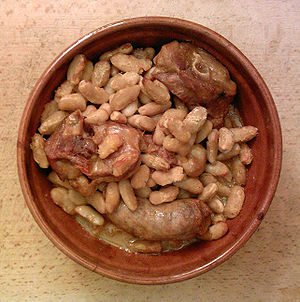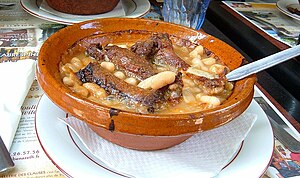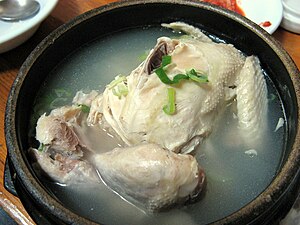| Cassoulet cuit (Photo credit: Wikipedia) |
Now granted, Cassoulet is no the most beautiful dish that you would ever put on the table. I usually serve mine by candlelight. But it is the essence of comfort food. Rich, warm, delicious. And I have found it freezes very well, so making a batch without company is still well worth the effort.
I always start from scratch - Nana Kate would call anything less "cheating." So no canned beans. To make this right, you'll have to start the night before with the soaking process - so all in all give yourself about 12 hours to get this done. Longer if you have to run by the store to pick up the ingredients - there are lots. BUT Cassoulet was peasant food - so use what you have, substitute, experiment, have fun, and don't sweat the results.
INGREDIENTS:
| White beans (Photo credit: Wikipedia) |
PREPARATION
1. Soak those beans! Put the beans in a pot and cover with 2" of water over night. In the morning rinse them off and drain in the colander.
2. Pour your bean into your pot with the water, broth, tomato paste, onion, and 1/2 the garlic. Now here's the oolala French-ie part: put the celery, bay, cloves, parsley, and peppercorn onto a cheese cloth and tie the ends together to make a bag and throw it in the liquids (It's called a "bouquet garnis.') Bring everything to a boil, then reduce to simmer (uncovered) until your beans are tender. This takes a little less than an hour.
3. During the simmer - cut the meat from your duck legs and put it in a bowl. Throw the bones in with your beans.
4. Pour in your tomatoes and let simmer another 15 minutes.Cook your duck meat and
sausage.
5. preheat your oven to 350 F
6. Remove the bouquet garni and bones.
7. Stir in the meats salt and pepper and the rest of your garlic
8. Ladle everything into a casserole dish.
9. Spread you breadcrumbs over the top and cook in the middle of your oven until it's bubbly - about an hour.
| (Photo credit: Wikipedia) |
See? Not complicated - just... long. And delicious! Nana Kate made this every time it snowed. She sevred it with fresh baguette and a tossed salad.



















